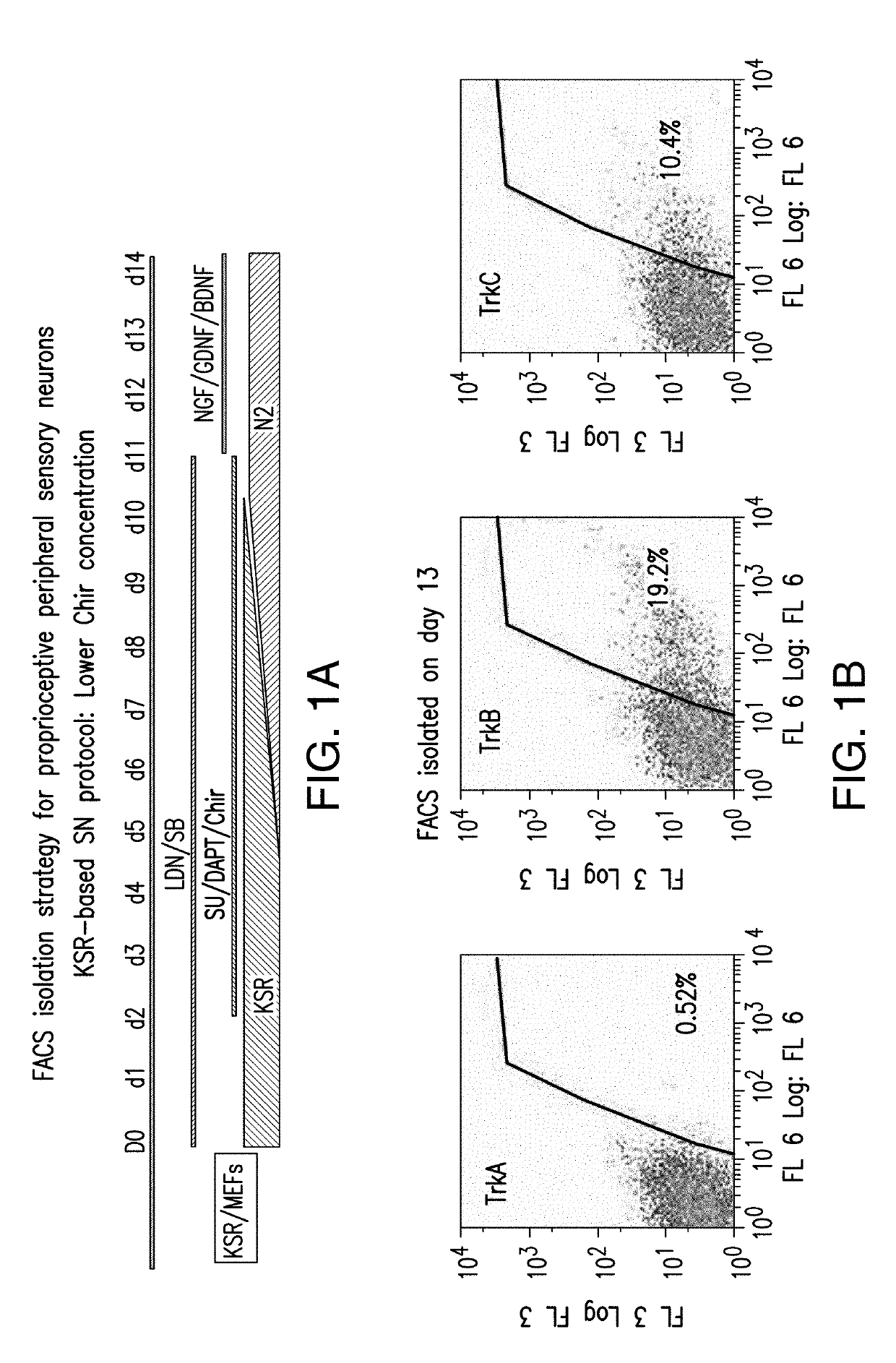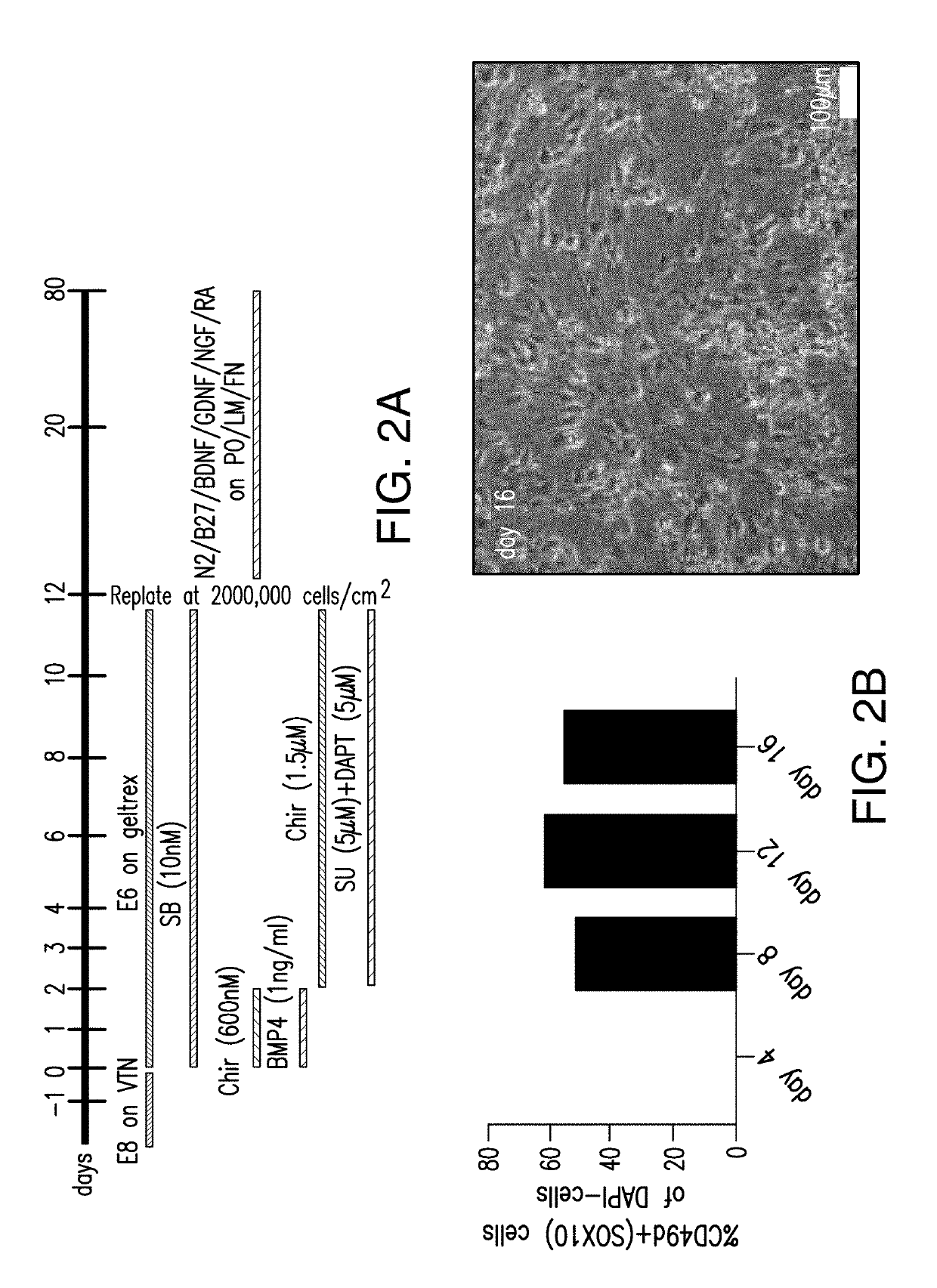Methods of diffrentiating stem cell-derived proprioceptors
a stem cell and proprioceptor technology, applied in the field of stem cell-derived proprioceptor diffrentiation, can solve the problems that the method of stem cell proprioceptors (e.g., human stem cells) has not been developed in the field
- Summary
- Abstract
- Description
- Claims
- Application Information
AI Technical Summary
Benefits of technology
Problems solved by technology
Method used
Image
Examples
example 1
uring Methods for Inducing Proprioceptors from Human Stem Cells
[0389]Human embryonic stem cells (hESCs) were cultured on mouse embryonic fibroblasts (MEFs, Globalstem, Rockville, State of Maryland, United States of America (USA)) in a medium comprising Dulbecco's Modified Eagle Medium (DMEM) / F12, 20% knockout serum replacement, 2 mM L-glutamine (Invitrogen, Carlsbad, State of California, USA), 100 μM MEM non-essential amino acids (Invitrogen). 10 ng / ml Fibroblast growth factor 2 (FGF-2, R&D Systems, Minneapolis, State of Minnesota) was added after sterile filtration and cells were fed daily and passaged weekly.
[0390]To induce neural differentiation, cells were plated on matrigel coated dishes and differentiations were induced once 100% confluency was reached, typically 24 hours after plating using Knockout Serum Replacement (KSR) media containing 820 ml of Knockout DMEM, 150 ml Knockout Serum Replacement, 1 mM L-glutamine, 100 μM MEM non-essential amino acids, and 0.1 mM β-mercaptoe...
example 2
uring Methods for Inducing Proprioceptors from Stem Cells
[0391]An E8 / E6 medium was used to different human stem cells into sensory neurons, including nociceptors, proprioceptors, and mechanoceptors. As shown in FIG. 2A, 600 nM CHIR99021 and 1 mg / mL BMP4 were added daily to the E8 / E6 medium on day 0 and day 1, 10 nM SB was added daily to the E8 / E6 medium from day 0 through day 12, 1.5 μM CHIR99021, 5 μM SU and 5 μM DAPT were added daily to the E8 / E6 medium from day 2 through day 12. On day 4, day 8, day 12, and day 16, the cells were measured for CD49d expression. As shown in FIG. 2B, sensory neurons were derived from SOX10-positive neural crest lineage. On day 16 and day 20, cells were stained for BRN3A, TUJ1, and DAPI. As shown in FIG. 2C, majority of the cells at day 16 and day 20 had a peripheral sensory neuron character.
[0392]Morphology of the generated sensory neurons at day 27, day 56 and day 80 was studied and the results are shown in FIG. 3A. As shown in FIG. 3A, the cells t...
PUM
| Property | Measurement | Unit |
|---|---|---|
| time | aaaaa | aaaaa |
| concentration | aaaaa | aaaaa |
| concentration | aaaaa | aaaaa |
Abstract
Description
Claims
Application Information
 Login to View More
Login to View More - R&D
- Intellectual Property
- Life Sciences
- Materials
- Tech Scout
- Unparalleled Data Quality
- Higher Quality Content
- 60% Fewer Hallucinations
Browse by: Latest US Patents, China's latest patents, Technical Efficacy Thesaurus, Application Domain, Technology Topic, Popular Technical Reports.
© 2025 PatSnap. All rights reserved.Legal|Privacy policy|Modern Slavery Act Transparency Statement|Sitemap|About US| Contact US: help@patsnap.com



